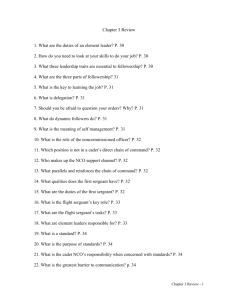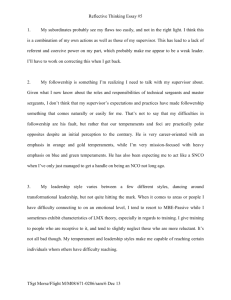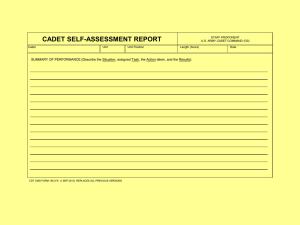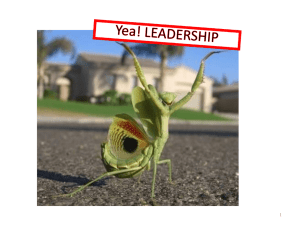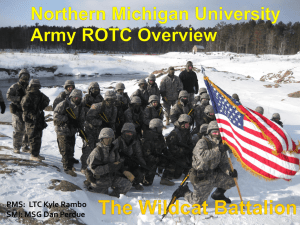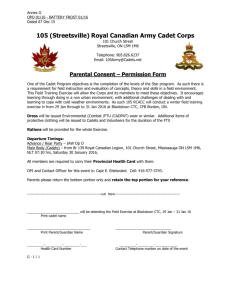Wright Brothers Leadership Laboratory
advertisement
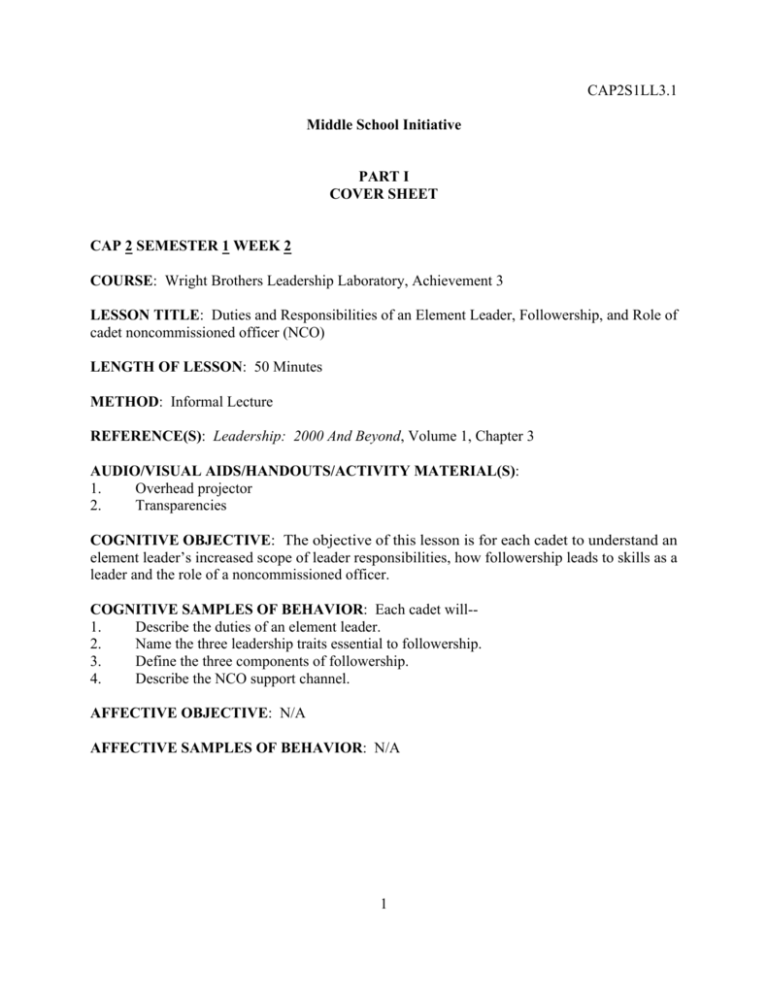
CAP2S1LL3.1 Middle School Initiative PART I COVER SHEET CAP 2 SEMESTER 1 WEEK 2 COURSE: Wright Brothers Leadership Laboratory, Achievement 3 LESSON TITLE: Duties and Responsibilities of an Element Leader, Followership, and Role of cadet noncommissioned officer (NCO) LENGTH OF LESSON: 50 Minutes METHOD: Informal Lecture REFERENCE(S): Leadership: 2000 And Beyond, Volume 1, Chapter 3 AUDIO/VISUAL AIDS/HANDOUTS/ACTIVITY MATERIAL(S): 1. Overhead projector 2. Transparencies COGNITIVE OBJECTIVE: The objective of this lesson is for each cadet to understand an element leader’s increased scope of leader responsibilities, how followership leads to skills as a leader and the role of a noncommissioned officer. COGNITIVE SAMPLES OF BEHAVIOR: Each cadet will-1. Describe the duties of an element leader. 2. Name the three leadership traits essential to followership. 3. Define the three components of followership. 4. Describe the NCO support channel. AFFECTIVE OBJECTIVE: N/A AFFECTIVE SAMPLES OF BEHAVIOR: N/A 1 CAP2S1LL3.1 Middle School Initiative PART II TEACHING PLAN Introduction ATTENTION: How many of you are ready to become leaders and supervise an element or squadron? MOTIVATION: Today’s lesson begins a series of lessons on how to change from a follower to a leader in the cadet squadron. OVERVIEW: During this period, we will discuss the duties and responsibilities of an element leader, discuss the art of being a good follower, and then, learn the role of a noncommissioned officer or NCO. TRANSITION: While we are progressing through this class, if you have a question relating to this material, please feel free to ask it. Body TRANSPARENCY LL3.1.1 – Duties of an Element Leader MP 1 Duties of an element leader. As an element leader for your flight, you have a responsibility for the cadets assigned to you. These responsibilities include performing specific duties such as teaching basic drill movements, relaying information to them, and positioning them within the element. This includes uniform inspection and taking care of the troops assigned to the element. 1. Element leaders also have an increased scope of leader responsibility. You are now responsible for the members of your element and, also, to work with and through your assistant element leader, when assigned. 2. Another responsibility you must undertake as an element leader is to ensure your cadets are prepared for their achievement and physical fitness tests. In addition, attendance at moral leadership briefings and activities are also essential for the cadets to complete their requirements for each achievement. TRANSPARENCY LL3.1.2 – Leadership Traits Essential to Followership 2 CAP2S1LL3.1 MP 2 Three leadership traits essential to followership. The three leadership traits essential to followership are: 1. Loyalty – to build teamwork. You must be loyal to your unit. Putting the unit ahead of your own needs, and the needs of others reflects loyalty to the unit. 2. Integrity – to preserve yourself within the larger unit. Integrity is more than being honest, it is the conviction to support your unit when others want you to support their needs. Wearing of the uniform properly is an example of integrity. You are representing yourself, your unit, CAP-USAF and your country. 3. Self-Discipline – to function as a team member, not a "prima donna." Having selfdiscipline will make you a leader. A self-disciplined individual follows the rules, standards, and regulations and places the good of the unit above themselves. TRANSPARENCY LL3.1.3 – Three Components of Followership MP 3 Three components of followership. The three components of followership are: the job, leader-follower relationship, and responsibility of the follower. TRANSPARENCY LL3.1.4 – The Job 1. The Job a. Know what the job is – know exactly what your leader expects of you and what you need to do to accomplish the job. b. Know how to do the job. Make sure you know how to do the tasks assigned to you. If you do not know, ask, don’t waste your time and the unit’s resources because you did not know how to do the job. c. Do the job. Your leaders expect results, not excuses. A job done correctly will provide you self-satisfaction. Success at completing the job will earn you rewards, praise, help toward your next promotion and you will also demonstrate your capability for added leadership responsibilities. TRANSPARENCY LL3.1.5 – Leader-Follower Relationship 2. Leader-follower relationship. Success at any job is having a good relationship with your leader. Getting along with your leader helps accomplish unit goals. Go to extra lengths to make sure you get along with your leader. Two things you can do to ensure success: a. Follow your leader’s orders. Understand what is being asked of you to accomplish and, if you think the outcome of your tasks will be different, immoral or unethical request clarification of the orders given you. Leaders are human like the rest of us and can make 3 CAP2S1LL3.1 mistakes. One of your responsibilities is to help your leader avoid mistakes and accomplish the unit goals. b. Job accountability. Once assigned a job, complete the job accurately, on time and inform your leader. Informing your leader when the job is completed is part of accomplishing the job. Being accountable for completing the job is a leadership responsibility. Your leader is also accountable to his/her leader for job completion. Everyone is accountable to a leader for job accomplishment and to inform his or her leaders. TRANSPARENCY LL3.1.6 – Responsibilities of a Follower 3. Responsibility to yourself. As a follower, you have a responsibility to yourself for advancement. a. Dynamic followers do not wait. Take responsibility for your own leadership growth. Be professional in all you undertake, become an expert in the job, and ask for leadership jobs to gain experience as a leader. b. Wise followers learn. Look for opportunities to gain the professional experience of a leader. Accept jobs as learning experiences, rather than say, "That's not my job!" c. Responsible followers manage themselves productively. The greatest challenge as a follower is to manage yourself productively. Always be productive in your job and with people. Self-management means controlling both your emotions and your behavior. Don't react to everything around you. Be aware of how you act and how others react to you. Try to inspire confidence and not chaos. Always act in a positive way to get the job done and to help your subordinates. Remember, you are teaching your followers to become leaders and setting the right example is paramount! TRANSPARENCY LL3.1.7– Role of the NCO MP 4 The Chain of Command is the succession of commanding officers through which command is exercised. There is only one Chain of Command in Civil Air Patrol, but it is paralleled and reinforced by the NCO Support Channel. 1. Role of the NCO. The role of the NCO is to make the chain of command work. The NCO corps consists of the cadet first sergeant, flight sergeant and element leader. a. First Sergeant. The first sergeant is the most responsible position with the highest leadership qualities of any NCO in the cadet structure. The first sergeant oversees routine activities such as inspections, training, attendance, and cadet progress. b. Flight Sergeant. The flight sergeant is a key person in the unit. The flight sergeant acts as the flight commander, when the flight commander is absent. The flight 4 CAP2S1LL3.1 sergeant's tasks include conducting inspections, teaching how to wear the uniform, customs and courtesies, discipline, drill and gathering information from the element leaders. c. Element leader. The element leader is responsible for knowing where the members of their elements are both when present or absent from unit activities. They also get information on their people's needs and correct them on personal appearance. As an element leader, you must learn about the needs of your people. You should ask yourself these questions: (1) What can each cadet do? (2) What parts of the next achievement have each cadet completed? (3) Do cadets need tutoring? (4) Are they prepared for their physical fitness test yet? (5) Do they have a ride to the next activity/meeting? Asking these questions is your challenge as a NCO. A NCO is specifically interested in their cadet's progress toward the next achievement and finding out if they are having problems. You, as a NCO, are the first line supervisor in helping cadets resolve their problems and achieving success in the unit. 2. Noncommissioned Officer Support Channel. The NCO support channel is a communication system consisting of the first sergeant, cadet flight sergeants and each element leader. This support channel passes information among themselves and proposes solutions for routine, but important, actions. This leaves the cadet commander free to plan, make decisions, and program future training and operations. 3. One important aspect of the support channel is the staff meeting. The support channel staff meeting consists of all the cadet flight sergeants and element leaders. This is a way for the first sergeant to keep the support channel informed about what he/she learns from the cadet commander. 4. The support channel is a formal, directive-based channel. Its directives are made by the first sergeant based on input from the flight sergeants and element leaders. These directives are coordinated with the cadet officers to prevent duplication or contradiction of other directives. These directives are the rules that will be followed for accomplishment of unit goals. 5 CAP2S1LL3.1 Conclusion SUMMARY: During this class we: 1. 2. 3. 4. Discussed the duties of an element leader. Discussed the three leadership traits essential to followership. Defined the three components of followership. Described the NCO Support Channel and its relation to the chain of command.. REMOTIVATION: Are you ready to become an NCO? CLOSURE: In preparation for your next leadership class, read Pages 3-6 to 3-10, Chapter 3, in your leadership laboratory manual – Leadership: 2000 And Beyond. Be prepared to discuss standards and barriers to communication. 6 CAP2S1LL3.1 Middle School Initiative PART III LESSON REVIEW LESSON OBJECTIVE(S): Each cadet will-1. Describe the duties of an element leader. 2. Name the three leadership traits essential to followership. 3. Define the three components of followership. 4. Describe the NCO support channel. LESSON QUESTIONS: 1. Describe the duties of an element leader. Answer: 2. a. b. c. Loyalty – to build teamwork Integrity – to preserve yourself within the larger unit Self-Discipline – to function as a team member, not a “prima donna” Define the three components of followership. Answer: 4. Teach your element basic drill movements Relay information Position cadets within a flight Name the three leadership traits essential to followership. Answer: 3. a. b. c. a. b. c. The Job Leader-follower relationship Responsibility to yourself Cadet will describe the NCO Support Channel. Answer: The NCO support channel is a communication system consisting of the first sergeant, cadet flight sergeants and each element leader. This support channel passes information among themselves and proposes solutions for routine, but important, actions. This leaves the cadet commander free to plan, make decisions, and program future training and operations. 5. What is the purpose of the NCO Support Channel? Answer: Collect and compare information on the cadet unit, identify problems and alternate solutions, and pass this information up the chain of command to the cadet commander. 7 CAP2S1LL3.1 6. Explain the demonstration-performance teaching technique. Answer: The demonstration-performance method is a proven method for teaching mental or physical skills, which require student practice for skill mastery. This method is based on the principle that students learn best by doing. 7. List the phases involved in a drill demonstration-performance teaching technique. Answer: The phases are: a. b. c. d. Explanation Demonstration Performance-supervision Evaluation 8
